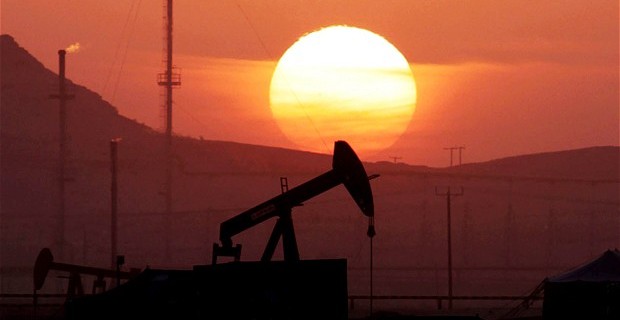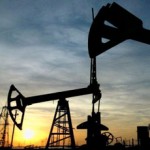An Old Formula May Overstate U.S. Oil Supplies

Jan Arps is the most influential oilman you’ve never heard of. In 1945, Arps, then a 33-year-old petroleum engineer for British-American Oil Producing Co., published a formula to predict how much crude a well will produce and when it will run dry. The Arps method has become one of the most widely used measures in the industry. Companies rely on it to gauge the profitability of drilling, secure loans, and report reserves to regulators. When Representative Ed Royce (R-Calif.) said at a March 26 hearing that the U.S. should start exporting its oil to undermine Russian influence, his forecast of “increasing U.S. energy production” could be traced back to Arps.
The problem is the Arps equation has been twisted to apply to shale technology, which didn’t exist when Arps died in 1976. John Lee, a University of Houston engineering professor and an authority on reserves, says billions of barrels of untapped shale oil are counted by companies relying on limited drilling history and tweaks to Arps’s formula that exaggerate future production. “Things could turn out more pessimistic than people project,” says Lee. “The long-term production of some of those oil-rich wells may be overstated.”
Lee’s criticisms have opened a rift in the industry about how to measure the stores of oil trapped within rock formations thousands of feet below the earth’s surface. In a newsletter published this year by Ryder Scott, which helps drillers calculate reserves, Lee called for an industry conference to address what he says are inconsistent approaches. The Arps method is particularly open to abuse, he says.
U.S. oil production has increased 40 percent since the end of 2011 as drillers target layers of oil-bearing rock such as the Bakken shale in North Dakota, the Eagle Ford in Texas, and the Mississippi Lime in Kansas and Oklahoma, according to the Energy Information Administration. The U.S. is on track to become the world’s largest oil producer by 2015, says the Paris-based International Energy Agency. A report from consultants Wood Mackenzie says that by 2020 the Bakken’s output will be 1.7 million barrels a day, up from 1.1 million now.
Rising reserve estimates give the U.S. a false sense of security, says Tad Patzek, chairman of the department of petroleum and geosystems engineering at the University of Texas at Austin. “We have deceived ourselves into thinking that since we have an infinite resource, we don’t need to worry,” he says. “We are stumbling like blind people into a future which is not as pretty as we think.”
The Arps formula is only as good as the data a company puts into it, Patzek says. Estimates can be inflated when Arps relies on limited drilling history for data or on a few high-performing wells to predict performance across a wide swath of acreage. Forecasts can also be skewed higher by assuming slower production declines than Arps observed.
In November 2012, SandRidge Energy (SD) cut its reserve predictions to the equivalent of 422,000 barrels per well from 456,000 barrels. Five months later, the estimate was cut again, to 369,000 barrels, company records show. SandRidge has since made a small adjustment upward to 380,000 barrels. The early forecasts were based on a small number of high-performing wells, which led the company to overestimate performance for its other acreage, says Duane Grubert, SandRidge’s executive vice president for investor relations and strategy. The company now has more than 1,100 wells and has improved its drilling. It is confident that current estimates are reliable. “Nobody knew that until we actually ground-truthed the field by drilling it,” Grubert says. “What we came up with was, hmm, that initial estimate was a little high.”
SM Energy (SM) of Denver suffered a similar setback this year when its wells in the Eagle Ford shale in Texas fell short of forecasts. The company on Feb. 18 cut its prediction in one area to the equivalent of 475,000 barrels per well from 602,000. Estimating future production from early data is a challenge, says Brent Collins, a company spokesman. “This is especially true when you are trying to estimate an average from a limited number of wells.” Both SandRidge and SM Energy use variations of the Arps method, company records show.
Tapping shale formations differs from the drilling in Arps’s day, says Dean Rietz, an executive vice president in charge of reservoir simulation at Ryder Scott. In 1945, oil production meant drilling straight down to hit pockets of oil and gas that had become trapped after migrating upward from deep layers of rock. Today’s drilling targets those deep layers, boring through thousands of feet of the earth’s crust, then turning sideways to chew for a mile or more through layers harder and less porous than a granite countertop. The rock is shattered by a jet of water, sand, and chemicals to create a network of small cracks to allow the oil and gas to escape. These fractured wells seem to follow a different decline trajectory than the wells Arps studied, says Lee.
Some in the industry defend Arps. “As far as Arps being old, the wheel was invented a long time ago, but it still comes in handy,” says Scott Wilson, senior vice president at Ryder Scott. Others are working to replace the Arps calculation. Researchers are testing new formulas with names worthy of an indie band: Stretched Exponential, which Lee helped develop; the Duong Method, devised by Anh Duong, principal reservoir engineer for ConocoPhillips (COP); and Simple Scaling Theory, which the University of Texas’s Patzek worked on. Rietz has made a computer model that simulates oil production. “Come back to me in 10 years, and I’ll tell you how reliable it was,” he says.
(By Asjylyn Loder)
Source: businessweek





























